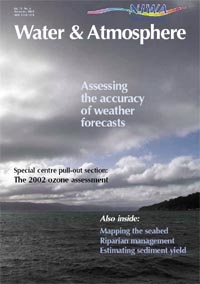PDF of this article (126 KB)

Stephanie Parkyn Rob Davies-Colley
How effective are riparian zones at protecting streams from the effects of land-use change?
Stream riparian management projects are being undertaken across New Zealand in an attempt to reverse some of the impacts of land use on waterways. In pastoral farming, riparian management usually means fencing out livestock and planting trees along stream margins to create buffer zones. Expectations are that riparian planting schemes will help deal with problems including channel instability, degraded aquatic habitat, and water pollution from diffuse inputs, as well as improve aquatic and terrestrial biodiversity.
Can these small strips of land within a much larger agricultural landscape really solve all of these problems, and if so how long does it take?
Assessing riparian management
We assessed nine riparian management schemes on North Island streams in March 2000. The buffer zones had been fenced and planted for periods ranging from 2 to 24 years. We compared each to unbuffered control reaches upstream or to nearby streams where the riparian zone was grazed by livestock.
What is a riparian zone?

The lengths of stream protected by buffer zones ranged from 200 to 4000 m above our sample reach. Streams were small to medium-sized (channel widths 1.5 to 8 m). We used macroinvertebrate community composition as the main indicator of water and habitat quality. We also assessed the stream habitat including temperature (measured over 3 weeks), water quality (from chemical analysis of a water sample), and visual water clarity (using the black disc method).
Overall, streams within buffer zones showed quite a few improvements compared to the control reaches, as shown in the table. Improvements could occur quite quickly. For example, a small Raglan stream showed improved stability and reduced nutrient contamination after only 2 years. However, responses were variable across streams.
Macroinvertebrate communities shifted significantly towards “clean water” or native forest communities at only three of the nine sites. Streams that showed improvement had well-established canopy trees and detailed analysis suggested that improvements here were linked to decreases in water temperature. Therefore, restoration of stream invertebrate communities might be expected only after the plantings had grown big enough to shade the stream.
(Some results from this study are shown in a table comparing the riparian management schemes assessed in this study.)
Some lessons
Riparian management can improve both water quality and habitat for aquatic life, but bear in mind the following points in your expectations of riparian management:
- It won’t happen overnight! Water quality may improve quickly, but restoration of shade and temperature, and thereby stream aquatic life, could take decades.
- What are the farmers upstream doing? If upstream reaches are unprotected by fences and/or buffer zones, your restoration efforts will be affected by livestock access and the lack of contaminant filtering and shade.
- Do you have native forest in the headwaters or nearby? Biodiversity in the stream and riparian area may only improve if there are sources of aquatic animals and pathways for them to recolonise the stream (e.g., adequate microclimate for the adult aquatic insects that fly).
The key to improving water quality and restoring ecological diversity is connection. We think that rehabilitation of streams is most likely to be successful when planting in riparian zones begins from the headwaters and progresses down through the catchment to produce a long, continuous buffer.
What is a riparian zone?

“Riparian” is derived from the Latin word ripa meaning river bank, so riparian zone refers to the land beside a stream. This land interacts with rainwater runoff from hillslopes (1) and with stream water when this overflows onto the flood plain (2). A forested or well-vegetated riparian zone affects the stream by intercepting runoff, providing shade that keeps water temperatures cool, providing leaf matter and wood for habitat and food, and stabilising stream banks.
What is riparian management?


Land-use change has dramatically altered riparian areas. For example, pasture land was formed by removing trees and adding livestock, which in turn affects water temperatures, quality and nutrient levels. Riparian management aims to reverse some of the impacts of land-use change by filtering contaminants before they reach the stream water, and restoring the functions provided by trees (shade, bank stability). Methods include:
- fencing, so stock can’t get into streams;
- leaving a buffer of long grasses;
- replanting trees.
Teachers: this article can be used for NCEA Achievement Standards in Biology (1.4, 2.5, 2.9, 3.2), Science (2.3), Geography (1.3, 3.6). See other curriculum connections at www.niwa.co.nz/pubs/wa/resources
Stephanie Parkyn and Rob Davies-Colley are based at NIWA in Hamilton. NB: There are additional images of the study streams in the PDF of this article.
Further reading
Collier, K.; Cooper, A.; Davies-Colley, R.; Rutherford, J.; Smith, C.; Williamson, R. (1995). Managing riparian zones: a contribution to protecting New Zealand’s rivers and streams. NIWA/Department of Conservation, Wellington.
Ministry for the Environment (2001). Managing waterways on farms. MfE, Wellington.
Parkyn, S.M.; Davies-Colley, R.; Halliday, N.J.; Costley, K.J.; Croker, G.F. (2003) Planted riparian buffer zones in New Zealand: do they live up to expectations? Restoration Ecology 11:436–447.
